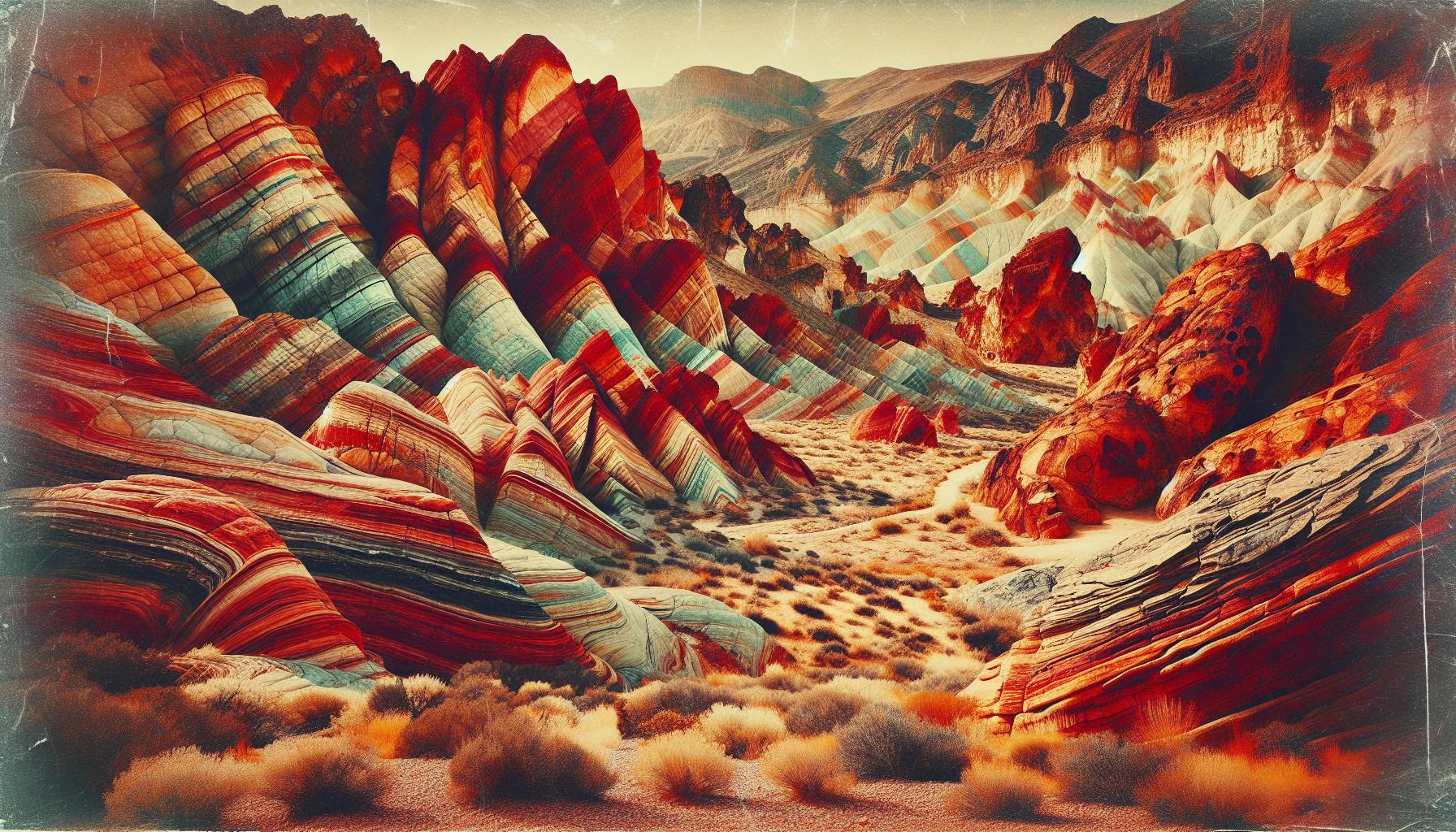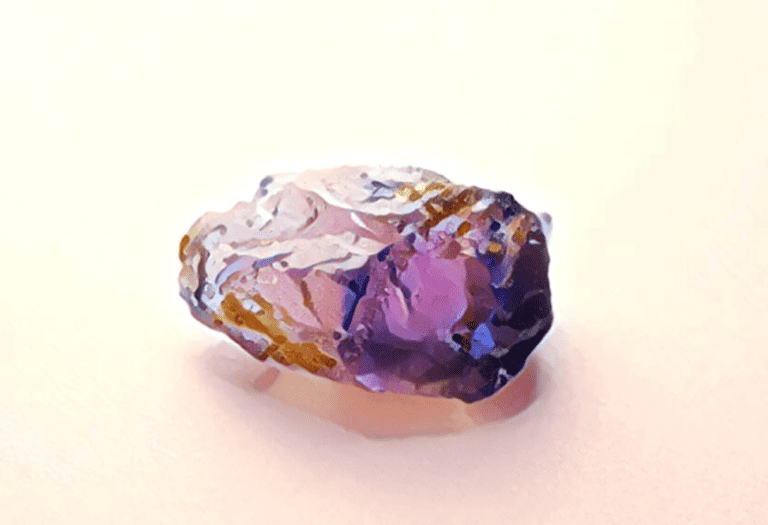Nevada’s vast, arid landscape is a treasure trove for rockhounds seeking the thrill of discovery.
With its rich mining history and geologic diversity, you’re in for a real adventure. Whether you’re a seasoned collector or a curious newbie, the Silver State’s hidden gems are waiting for you.
From the fiery opals of Virgin Valley to the glittering geodes of Garnet Hill, Nevada’s offerings are as diverse as they are abundant. You’ll find yourself scouring the rugged terrain for agates, turquoise, and even ancient fossils.
Get ready to fill your pockets and expand your collection with Nevada’s natural wonders.
Nevada, a rockhound’s paradise, offers diverse rockhounding sites. Key locations include Virgin Valley for black fire opals, Royston Turquoise Mine for turquoise, Garnet Hill for garnets, and Wilson Canyon for geodes and Apache tears. Ensure you research access rights and follow “leave no trace” principles for sustainable collecting.
Nevada Rockhounding Locations
Nevada’s vast landscape holds an abundance of rockhounding spots, each offering a unique set of minerals and geological specimens. Whether you’re a beginner or an experienced rockhound, these locations are sure to enrich your collection.
Virgin Valley is renowned for its black fire opals, which are among the most sought-after gems in the world. This region, nestled in the northern part of the state, has several mines that allow the public to dig for their own opals. If you’re lucky, you might unearth an opal with a play-of-color that dazzles the eye. Just remember that the mines may charge a fee and have specific rules for digging and collecting.
Heading south, the Royston Turquoise Mine is a hotspot for those seeking turquoise. This mine offers the chance to find your own pieces of the famed blue-green mineral that’s synonymous with Southwestern jewelry. Turquoise from Royston is known for its beautiful matrix patterns, making each find truly unique.
For those who love variety, the Garnet Hill near Ely is a must-visit location. Here, you can not only find garnets embedded in the volcanic rock but also an assortment of other minerals. It’s a perfect place for a family outing, with a scenic view and treasures littering the ground.
- Virgin Valley: Black Fire Opals
- Royston Turquoise Mine: Turquoise
- Garnet Hill, Ely: Garnets and assorted minerals
Lastly, don’t overlook the alluring Wilson Canyon near Yerington, where you can discover a mix of geodes, agates, and Apache tears. These volcanic glasses are a stark reminder of Nevada’s fiery geological past.
Before you set out on your adventure, ensure you’ve thoroughly researched access rights and land ownership as many prime rockhounding areas are on private property or may require permits. It’s also essential to follow the “leave no trace” principles to preserve these sites for future generations of rockhounds.
What Gemstones are Found in Nevada?

Nevada, often known as the Silver State, is not only rich in silver but also boasts a plethora of gemstones. You will find that Nevada’s diverse geology is a treasure trove for rockhounds, with an astonishing variety of minerals just waiting to be unearthed.
Turquoise is arguably one of the most notable gemstones that you can find in Nevada. This blue-green mineral is highly sought after for jewelry and is synonymous with the state’s gemstone heritage. The Lander County is especially renowned for its premium quality turquoise.
In addition to turquoise, the state is famous for its extraordinary Opals. Nevada is one of the few places in the world where you can find the precious black fire opal. These striking stones are characterized by their dark background and vibrant play of colors. The Virgin Valley in Northern Nevada is your go-to destination for these opals.
Moving on, Red Beryl, also known as “Red Emerald,” is an extremely rare gemstone, and some deposits can be found in the Wah Wah Mountains of Nevada. While stones large enough to be cut into faceted gems are rare, any discovery of Red Beryl is a significant find.
Here’s a quick list of other gemstones that can be unearthed across various locales in Nevada:
- Garnets: Deep red crystals that are usually found in metamorphic rocks.
- Agates: Banded stones that come in various colors and patterns.
- Jasper: An opaque variety of quartz that presents in red, yellow, or brown.
- Chalcedony: Comes in a range of colors and is known for its waxy luster.
The state also yields a range of quartz crystals, including amethyst, smoky quartz, and clear quartz. These crystals can be found in counties like Elko, Esmeralda, and Nye.
As you continue your search for gemstones in Nevada, remember that regulations and permissions are key to a responsible and fruitful rockhounding experience. Ensure you’re adhering to the Bureau of Land Management guidelines and respecting private lands. Keep in mind that some areas may be restricted or have specific rules regarding collecting. It’s important to do your homework beforehand.
What Sedimentary Rocks You Can Find in Nevada?

Nevada’s geological landscape is a mosaic of rock types, including a fascinating variety of sedimentary rocks. As you explore Nevada’s sprawling deserts and mountain ranges, limestone and shale can be commonly found. These are remnants of ancient sea beds and have been shaped through eons by the persistent forces of water and wind.
In places like Valley of Fire State Park, your eyes will be treated to vibrant red sandstone formations. The park’s Aztec Sandstone is renowned, offering more than just visual splendor; it’s a favorite among rockhounders seeking unique specimens. Sandstone is typically formed by the consolidation of sand, and in Nevada, it’s often beautifully colored by iron oxides.
Another notable location is the Fossil Hill in the Humboldt Range, where marine fossils are abundant in the sedimentary deposits. This area gives insights into the prehistoric life that once thrived in the region. Moreover, you might stumble upon dolomite, a mineral rock that’s similar to limestone but contains magnesium. It is often used in the production of cement and as an aggregate material.
If your adventures take you to the southern regions of Nevada, keep your eyes peeled for gypsum near dry lake beds. This soft sulfate mineral, crucial to the creation of plaster and wallboard, gleams with a crystalline allure under the desert sun.
| Rock Type | Locations in Nevada | Characteristics |
|---|---|---|
| Limestone | Various locations | Ancient sea bed remnants, often fossil-rich |
| Shale | Widespread | Formed from compacted mud and silt |
| Sandstone | Valley of Fire State Park | Red-hued from iron oxides, used in construction |
| Fossil | Fossil Hill in Humboldt Range | Contains marine fossils from a prehistoric sea |
| Dolomite | Humboldt Range | Contains magnesium, used in construction |
| Gypsum | Southern Nevada dry beds | Soft, used in plaster and wallboard creation |
What Metamorphic Rocks are found in Nevada?
When exploring Nevada’s diverse terrain, you’ll quickly discover that it’s a treasure trove for rockhounds seeking metamorphic rocks. Metamorphic rocks are those that have been transformed by extreme heat and pressure, leading to new textures and mineral compositions not found in the rock’s original state. In Nevada, you can find an impressive array of these geological wonders.
Slate, with its fine grain and durability, is a common find in the state. Specifically, areas around the Valley of Fire State Park are known for their abundance of slate. This park also offers breathtaking landscapes that are a byproduct of the same tectonic activity that forms metamorphic rocks.
Marble is another metamorphic rock you’ll encounter in Nevada. Historically significant, the Yule Marble Quarry in the Toiyabe National Forest has been a notable source of high-quality marble. The quarry may be non-operational, but the surrounding area still offers plenty for eager rockhounds.
Schist and gneiss are often discovered along Nevada’s mountainous ranges. These rocks are characterized by their layered appearance and can contain valuable minerals like garnets and staurolite. The presence of such rocks is a testament to the state’s dynamic geological history, involving ancient volcanic and tectonic activity.
Nevada’s landscape also includes rare finds like Greenstone, which is highly sought after by collectors. Areas near Great Basin National Park are well-known spots to search for this unique rock, providing another exciting quest for rock enthusiasts.
As our map guides your rockhounding journey, remember to respect the environment and adhere to local guidelines. Not only does this preserve these sites for future visitors, but it also ensures that the hobby of rockhounding can continue to be enjoyed by all. Equip yourself with a sturdy hammer, safety glasses, and a field guide to better identify and collect these metamorphic beauties scattered throughout Nevada’s vast geology.
What Igneous Rocks can You Find in Nevada?
Venturing through Nevada’s diverse geology, you’ll encounter an impressive range of igneous rocks formed from volcanic activity and the cooling of magma. One of the most intriguing findings could be Obsidian, a glass-like volcanic rock that varies in color from black to rich mahogany. Nevada’s mineral-rich ground lends itself to this gemstone’s formation, particularly in areas around old volcanic calderas and flow bands.
Granite is also prevalent in the Silver State. It’s an intrusive igneous rock, meaning it solidified from magma below the Earth’s surface. You can stumble across granite while exploring the state’s mountain ranges, where the slow cooling process of magma has resulted in this visibly coarse-grained rock, often admired for its sturdy and aesthetic appeal.
If you’re on the hunt for something unique, Nevada won’t disappoint. The state is a treasure trove for Pumice, the porous rock that’s light enough to float on water. The region around volcanic craters and ash deposits is where you’re most likely to find pumice stones scattered across the landscape.
Additional igneous specimens include:
- Rhyolite: Typically found in the southwestern parts of Nevada, known for its colorful and banded appearance.
- Basalt: Commonly found in the form of ancient lava flows and columns throughout Nevada.
- Peridotite: This rock is less common but is significant as a primary source of diamonds at the state’s older volcanic pipes.
Remember to keep an eye out for mineral deposits that often occur within these igneous rocks. Nevada is especially famous for its wealth of precious metals and minerals embedded in igneous formations, such as gold and copper, promising both a fascinating and potentially rewarding rockhounding experience.
Panning for Gold in Nevada
Have you ever dreamed of striking it rich by finding that glimmer of gold in the bottom of your pan? Nevada, known as the “Silver State,” has a legacy filled with gold rushes and mining operations. Gold panning in Nevada is not just a remnant of the past but a thriving recreational activity for those with patience and a keen eye.
When planning your gold-panning adventure, Northern Nevada is particularly rich with opportunities. The Carson River near Carson City is a famous spot for casual prospectors and seasoned veterans alike, where fine placer gold can often be found in the river’s gravel. The Truckee River, which winds its way down from the Sierra Nevada, also harbors fine gold particles for those willing to sift through its waters.
In the eastern part of the state, the Virgin Valley is not only home to opals but also has streams with fine gold deposits. Here’s a tip: bring along a classifier or a sieve to separate the larger rocks and gravel to increase your chances of revealing gold flakes.
Remember, you’ll need the right tools for an effective panning session:
- A durable gold pan with ridges
- A shovel or spade for digging
- A snuffer bottle to collect your finds
- A container or vial to store any gold
While you’re enjoying the thrill of the hunt, it’s vital to stay aware of your surroundings and respect private property. Always check with local authorities for any permits required to pan in designated areas. Public lands managed by the Bureau of Land Management (BLM) are often open to panning, but regulations can vary.
For a more structured experience, consider visiting one of the many pay-to-dig sites where you pay a fee to search for gold. These sites often provide you with equipment and instruction, making it an excellent starting point for beginners.
So whether you’re looking for a unique family outing or hoping to discover hidden treasure beneath Nevada’s sedimentary overlay, gold panning can add an exciting dimension to your rockhounding escapades.
Rocks and Minerals Found in Nevada
Nevada, renowned for its geological diversity, is a treasure trove for rockhounds like you. The state’s rich tapestry of geological formations harbors a spectacular array of rocks and minerals. Each type offers its own unique set of characteristics which make them highly sought after by enthusiasts and collectors.
Sedimentary Rocks: You’ll find an abundance of sedimentary rocks in Nevada. The state’s ancient seabeds have given rise to impressive limestone deposits characterized by their fossil content. Shale and sandstone are also prevalent, forming the structure of Nevada’s rolling landscapes.
- Limestone
- Shale
- Sandstone
- Dolomite
- Gypsum
Metamorphic Rocks: Metamorphic rocks in Nevada exhibit the transformative power of heat and pressure. Noteworthy among them are:
- Slate
- Marble
- Schist
- Gneiss
- Greenstone
These rocks bear the marks of their dynamic history with warped layers and new mineral alignments.
Igneous Rocks: The fiery temperament of Nevada’s past is etched into the igneous rocks scattered throughout the region. Volcanic eruptions have left behind a spectrum of rock types, from the sharp sheen of obsidian to the granular textures of granite and pumice. Ancestors to these rocks played host to molten metals, now cooled and solidified.
- Obsidian
- Granite
- Pumice
- Rhyolite
- Basalt
Precious Metals and Minerals: Nevada isn’t called the Silver State for nothing. The area is permeated with veins of silver and gold, remnants of a rich mining history that continues to this day. Chalcopyrite, galena, and sphalerite are minerals that often accompany these valuable metals, making Nevada an ideal spot for those looking to add some shiny specimens to their collection.
During your adventures in Nevada, keep an eye out for these natural treasures. Whether you’re skimming through the layers of shale for fossils or studying the unique banding of schist, you’re participating in a storied tradition of discovery and appreciation for the Earth’s underground wonders. Remember to tread lightly and respect the natural habitats you explore as they’ve been millions of years in the making.
Where Can I Find Fossils in Nevada?
Nevada’s terrain isn’t just a haven for rockhounders looking for minerals and precious stones; it’s also a treasure trove for fossil enthusiasts. If you’re keen on uncovering the remnants of ancient life, the Silver State offers several key locations where the conditions have preserved a wide array of fossils.
In the Fossil Hill area situated in the Humboldt Range, you’re likely to encounter marine fossils such as ammonites and trilobites. These species hearken back to a time when much of Nevada was covered by a warm shallow sea during the Paleozoic era. The Berlin-Ichthyosaur State Park, also highlights an impressive assortment of marine fossils, including the state’s official fossil, the Ichthyosaur, an ancient marine reptile.
Head over to Tule Springs near Las Vegas, where you might stumble upon fossils of mammals that roamed the area during the Pleistocene epoch. Here, specimens such as mammoths, camels, and giant sloths have been uncovered. In the Valley of Fire State Park, trace fossils like footprints and burrows make for an exciting find, alongside the visually stunning geological formations of Aztec sandstone.
When searching for fossils, always remember that it’s vital to respect the laws and regulations regarding fossil collection. Certain areas may require permits, and others prohibit the removal of fossils altogether. Always check with local authorities or park management before you set out.
Keep your eyes peeled for muted colors and unusual shapes in rocks, a telltale sign that something extraordinary might be hidden within. With patience, a keen eye, and a bit of luck, your next rockhounding trip in Nevada could lead to a significant paleontological discovery. Remember that preparation and knowledge of the terrain can greatly increase your chances of unearthing these hidden pieces of history.
Nevada Rockhounding Laws & Regulations
When planning your rockhounding adventure in Nevada, it’s crucial to stay informed about the state’s laws and regulations to ensure you’re collecting legally and ethically. Nevada’s public lands are managed by various agencies, and each has its own set of rules that you must follow.
On Bureau of Land Management (BLM) lands, you’re generally allowed to collect rocks and mineral specimens for personal use without a permit as long as you stick to certain limits. These include:
- Not collecting more than 25 pounds plus one piece per day
- A maximum of 250 pounds per year
Remember, these regulations are designed to preserve the natural beauty and resources of the areas for all visitors. It’s also important to be aware that collecting artifacts, archaeological finds, or vertebrate fossils is prohibited on public lands without an appropriate permit.
In Nevada State Parks, rockhounding activities are allowed in specific areas; however, you should check with the park staff before removing any material. Some parks may have designated collecting sites, and park-specific rules can vary significantly.
If you’re venturing onto private lands, permission from the landowner is a must before you begin any rockhounding—this is both a legal and a courtesy requirement.
Safety should be your priority. Be sure to wear appropriate gear and be mindful of the terrain and weather conditions. It’s also a good idea to carry a detailed map and let someone know your itinerary.
Lastly, familiarize yourself with the Leave No Trace principles. Pack out what you pack in, and minimize your impact to ensure the preservation of these spectacular environments for future generations.
As rockhounding gains popularity, it’s essential to operate within legal boundaries and respect the environment. Staying informed about Nevada’s rockhounding regulations not only protects you legally, but it also helps conserve these precious resources for years to come.
Rockhounding Tips for Beginners in Nevada
Gearing Up: Essential Tools for Rockhounding
Before you head out to the vast deserts and mountain ranges of Nevada, it’s crucial to equip yourself with the right tools for a successful rockhounding expedition. Start with a durable geologist’s hammer, which is indispensable for chipping off samples. Don’t forget a pair of gloves to protect your hands from sharp edges and a sturdy backpack to carry your finds. Here’s a quick checklist to get you started:
- Geologist hammer or pick
- Safety goggles
- Gloves
- Chisels and pry bars
- Collection bags or buckets
- Field guidebooks for identification
- Hand lens or magnifier
Remember, the right tools will not only make your hunt easier but also ensure that you collect specimens responsibly without damaging the surrounding environment or the samples themselves.
Safety Tips While Rockhounding
Rockhounding can be an adventurous hobby, but your safety should always come first. Always let someone know where you’re going and when you plan to return. Dress in layers to adapt to Nevada’s fluctuating temperatures and wear a hat and sunscreen to protect from the sun’s intensity.
More importantly, always carry sufficient water – dehydration is a serious risk in arid regions. Bring along a first-aid kit for unforeseen minor injuries. Watch your step for rattlesnakes and other wildlife that call the Nevada wilderness home. And always stay aware of your surroundings, especially when working with tools or near cliffs.
Legal Guidelines for Rockhounding Enthusiasts
As a beginner, it’s vital to understand that rockhounding is subject to specific legal guidelines that preserve natural habitats and cultural heritage. In Nevada, keep these points in mind to stay compliant:
- Collect only where it’s allowed; don’t trespass on private lands without permission.
- Familiarize yourself with BLM guidelines, as they oversee much of the public land where rockhounding is permissible.
- Refrain from collecting more than the allowable limit, which is typically up to 25 pounds per day plus one piece.
- Never remove archaeological or paleontological artifacts, and absolutely avoid collecting vertebrate fossils unless you possess a scientific permit.
Staying within these legal bounds ensures that you’re both respecting the law and doing your part to maintain Nevada’s geological diversity for future generations of rockhounds.
Conclusion: Nevada Rockhounding Locations
Embarking on your rockhounding adventure in Nevada, you’re now equipped with the knowledge of what treasures lie beneath the rugged landscape.
Whether you’re after the shimmer of obsidian, the classic beauty of marble, or the thrill of unearthing ancient fossils, you’ll find these geological wonders scattered across the state. Remember, your successful expedition hinges not just on your tools and techniques but also on your commitment to legal and responsible collecting. By respecting the land and its laws, you’ll ensure that Nevada continues to be a rockhounder’s paradise for years to come.
So grab your gear, follow the map, and let Nevada’s rich terrain surprise you with its hidden gems.







